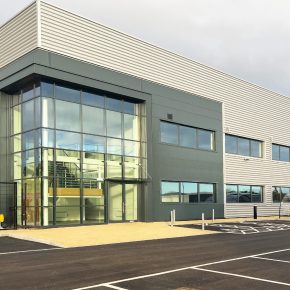
ASSA ABLOY: Five reasons why connected access control makes life easier for security managers
To enjoy the benefits of connected security, businesses need security technologies which work seamlessly with each other. In a recent survey of industry professionals, over 90% noted the critical importance of integration across building management functions.
But why is integration judged to be so important? What exactly are its benefits? And how can an organisation reap them? ASSA ABLOY has more…
In fact, there are several ways a connected system access solution can help a business to do more — both enhancing security and contributing to overall business success.
Control every system from a single seat
“Access control systems are often viewed as the starting point for a building to shift from operating in siloes, towards a more functional, connected and ‘integrated’ building management system,” explains a new IFSEC Global white paper on security management. The white paper considers integration’s cost and efficiency impact on organisations.
Control from a single, integrated interface boosts efficiency in many ways. Some are individual to the industry or business, but there are advantages which apply almost anywhere. Firstly, integration reduces training needs and therefore costs: Everything is administered from a single system, rather than several working in isolation.
Secondly, when facilities staff only consult or update one interface, they save time and reduce manual errors.
In a real-world situation, integration can even save facility managers’ journey time. At the InHolland University of Applied Sciences, for example, a Nedap AEOS system integrated with Aperio wireless devices controls access for seven different campuses from a single, integrated point.
Thirdly, analytics can deliver more value and better insights when multiple sources of data provide input.

Future-proof a system with standards-compliant hardware
Connected access control helps businesses to retool building management for the challenges of the 2020s. The smart building is integrated and automated, relying on standards for interoperability to keep data flowing in every direction.
OSDP, for example, streamlines the interoperability of access control and security devices. ONVIF Profile D & Profile M help access control devices connect with analytics.
Access control hardware which is designed for interoperability — with accessible APIs and SDKs for app integration — creates security which is ready for what’s next, even when predicting ‘what’s next?’ can be difficult.
Attract and retain staff with flexible working
In a survey conducted by consultants McKinsey & Company, 63% of employees said they would prefer a ‘hybrid’ or fully remote work schedule. To offer this kind of flexibility cost-effectively, security provision must be able to adapt. Smarter use of space is ever more important as employees come to favour hybrid work patterns.
To assist in a move to hybrid working, access control credentials can be authorised to unlock doors during specific timeframes, so staff enter only when scheduled, for example. Facility managers can regulate daily access so building occupancy stays within capacity.
A single hub — for issuing, amending and revoking access rights — streamlines the administration of a hybrid system. Trying to implement such a change via multiple electronic and/or mechanical access systems in parallel could create an enormous workload. Integrated electronic access control makes it easy.
Realise the cost saving potential of connectivity
According to analysts Verdantix, more than a third of building occupiers in the office sector are now planning to invest in space utilisation analytics.
An integrated access control system generates critical data for understanding building use — and potentially reducing office rental costs. If a space is not being used, why waste valuable budget on renting it?
Danny Laurier, of Securitas, in an exclusive interview for the white paper, comments: “Whereas security has mostly been a reactive profession prior to now, integrated solutions allow data to be transformed into knowledge. And, when you have knowledge, you can move from a reactive to predictive risk management approach.”
Boost the energy efficiency of a building or business
Extending a security system with integration-ready wireless locking can contribute to any business’ energy efficiency or sustainability strategy.
Wireless electronic locks use less cabling and consume less energy at installation. Carrying a single, flexible credential stored securely on a mobile phone reduces the use of plastics (cards) and metal (keys).
The emergence of electronic locks powered by energy-harvesting technology may even bring electricity consumed at the door down to zero. Quite a contrast to traditional wired door locking, which is often power-hungry.
Integration itself may also offer an efficiency boost, according to some sustainability experts: ‘A properly functioning BMS should deliver energy efficiency savings in the order of 15–20%… improving the operation of your BMS is probably the single most cost-effective energy efficiency measure you can take‘.
Connectivity is the driver of these improvements, contributing to commercial success while making life easier for everyone at the sharp end of facilities management.
A new white paper — ‘Boosting efficiency and streamlining security with an integrated access control solution‘ — provides essential background for all key decision-makers who are considering an integration project.
Contact ASSA ABLOY Opening Solutions EMEA Digital and Access Solutions
Dukes Court/Dukes Street
Woking
GU21 5BH
United Kingdom
Web: About us | ASSA ABLOY
Email: Thomas.schulz@assaabloy.com
Phone: 0049 30 8106 2970
Visit Supplier's page
Latest news

2nd April 2025
FIT Show 2025 Launches Innovative Marketplace Feature to Enhancing Value for Installers
FIT Show, the UK’s leading event for the window, door, flat glass, hardware, and roofing industries, is excited to announce the launch of a brand new Marketplace feature at its upcoming 2025 event (Birmingham NEC, 29 April – 1 May).
Posted in Architectural Ironmongery, Articles, Building Industry Events, Building Industry News, Building Products & Structures, Doors, Exhibitions and Conferences, Glass, Glazing, Hand Tools, Innovations & New Products, Plant, Equipment and Hire, Power Tools, Restoration & Refurbishment, Retrofit & Renovation, Roofs, Seminars, Training, Windows
2nd April 2025
Hi-spec deployment of EJOT Colorfast at new Birmingham logistics park
EJOT Colorfast fasteners have been used extensively in the construction of eight new high-specification warehousing and logistics buildings at the Urban 8 Logistics Park in King’s Norton, Birmingham.
Posted in Articles, Building Industry News, Building Products & Structures, Building Systems, Case Studies, Facades, Restoration & Refurbishment, Retrofit & Renovation, Roofs, Walls
2nd April 2025
SWA member delivers ‘fresh Hope’ for university’s Sustainable Building department
A detailed contract to restore an iconic Art Deco building in the heart of Birmingham’s Jewellery Quarter was carried out by Steel Window Association member, The Window Repair Company (Northwest) Limited.
Posted in Articles, Building Associations & Institutes, Building Industry News, Building Products & Structures, Building Systems, Case Studies, Glass, Glazing, Restoration & Refurbishment, Retrofit & Renovation, Steel and Structural Frames, Sustainability & Energy Efficiency, Windows
1st April 2025
Gilberts Takes Thermal Comfort to New Heights
Gilberts Blackpool is continuing to build on its reputation as a pioneer with the unveiling of ThermaAstute™ – the most extensive range of thermally sensitive diffusers in the market.
Posted in Air Conditioning, Articles, Building Industry News, Building Products & Structures, Building Services, Facility Management & Building Services, Heating, Ventilation and Air Conditioning - HVAC, Innovations & New Products, Restoration & Refurbishment, Retrofit & Renovation, Sustainability & Energy Efficiency
 Sign up:
Sign up: